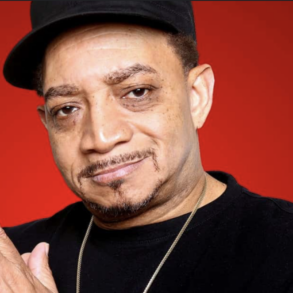Before hip-hop became an organized movement, its individual elements had already taken shape decades prior. By the early 70s, the South Bronx became the birthplace of a cultural revolution. This movement started with modest beginnings and has now grown into a global phenomenon, producing numerous business moguls while transforming art and culture. DJing, emceeing, breaking, and graffiti have evolved from casual hobbies to sophisticated expressions of skill. These Black artists, pioneers, and newer emcees have profoundly shaped the culture, leaving an indelible mark that has only enriched and elevated it.
DJ Kool Herc
Kool DJ Herc is the originator of breakbeat DJing, the essence of hip-hop. By isolating and repeating the “breaks,” or most danceable parts, of funk records by Mandrill, James Brown, and the Jimmy Castor Bunch, Herc created the prototype for modern-day hip hop. Though others, such as Grandmaster Flash, perfected and elevated the technique, Herc is credited for its creation. Herc began his career in the early ’70s, spinning funk records and isolating their breaks. Known for his all-night parties and powerful sound system, Herc’s career was sidelined after being stabbed, though he occasionally resurfaced in the ’90s.
Grandmaster Flash and the Furious Five
Grandmaster Flash and the Furious Five introduced innovative scratching techniques and social commentary to the music. Grandmaster Flash and the Furious Five, the first rap group inducted into the Rock Hall, elevated hip hop from party music to a weapon for social change. Their groundbreaking track “The Message” exposed the harsh realities of urban life, contrasting the genre’s typical party themes. Musically, their pioneering use of turntables and equipment transformed hip-hop’s sound. They crafted a powerful narrative that resonated widely, highlighting the struggles and frustrations of the inner city. Their legacy continues to influence and inspire generations of artists and listeners.
Their crossover appeal helped hip-hop gain a foothold in mainstream music. Run-D.M.C. pioneered the hardcore rap sound, blending heavy metal samples and spare beats, influencing groups like Public Enemy and N.W.A. They transitioned rap from singles to full albums and achieved mainstream success with hits like “Walk This Way.” Their third album, Raising Hell, reached the pop Top Ten and went platinum. Though their influence waned with albums like Tougher Than Leather and Back From Hell, they experienced a resurgence with Down With the King in 1993. Jam Master Jay’s tragic death in 2002 marked the end of an era for the iconic group.
Public Enemy
Public Enemy is known for their politically charged music and proactive stance in the Black community. The group revolutionized hip-hop, expanding its sonic vocabulary and amplifying its social impact. Led by Chuck D, they described their music as “the invisible TV station that Black America never had,” addressing community concerns with urgency. Their early albums, especially It Takes a Nation of Millions to Hold Us Back and Fear of a Black Planet, featured dense, cacophonic productions by the Bomb Squad and enduring classics like “Fight the Power.” Public Enemy’s influence persists, showcased by their 2013 Rock and Roll Hall of Fame induction.
Tupac Shakur
Tupac Shakur is a defining figure in hip hop for his poignant lyrics on life, injustice, and the struggles of Black people in America. With a natural ability to appeal to hedonists and revolutionaries alike, his charismatic star power and unapologetic attitude made him a standout in the ’90s. Emerging with Digital Underground, his solo debut, 2Pacalypse Now, earned him acclaim. Roles in films like Juice and Poetic Justice showcased his talent beyond music. Despite legal troubles, albums like All Eyez on Me cemented his legacy. His untimely death in 1996 shocked the world, but his influence endures through posthumous releases and accolades.
Kendrick Lamar
Kendrick Lamar’s profound lyrics and innovative sound have made him a critical voice in modern hip-hop. Born in Compton, California, he emerged as a leading figure in the genre with his storytelling and socially conscious themes. His albums, including good kid, m.A.A.d city, To Pimp a Butterfly, and DAMN., received widespread acclaim, earning him multiple Grammy Awards and even a Pulitzer Prize. Lamar’s work often addresses issues like racial inequality, inner-city struggles, and personal introspection. His influence extends beyond music into popular culture, making him a prominent and respected artist of his generation.
Megan Thee Stallion
Megan Thee Stallion is known for her fierce flows and Texan bravado while shaping the sound and culture of current hip hop. Houston rapper Megan Thee Stallion’s sexually charged lyrics and confidence meet a pop sheen, delivering hits. She found local success in 2016, with wider recognition soon after. Her mixtapes “Make It Hot” and “Tina Snow” led to chart-topping singles like “Savage” (remixed with Beyoncé) and “WAP” with Cardi B. Megan’s debut album Good News peaked at number two on Billboard 200. Her follow-ups, Something for Thee Hotties and Traumazine, showcased her versatility and cemented her status in music.
J. Cole’s thoughtful narratives and skilled lyricism continue to push the boundaries of hip-hop. Since his 2011 breakthrough, Cole has remained prominent, achieving commercial success with a pensive and lyrical approach. The first artist signed to Jay-Z’s Roc Nation, his debut album Cole World: The Sideline Story went double platinum, followed by a streak of number-one albums including Born Sinner, 2014 Forest Hills Drive, and KOD. Through Dreamville Records, Cole supports younger talent, producing the Grammy-nominated Revenge of the Dreamers III. His latest works include The Off-Season, D-Day: A Gangsta Grillz Mixtape, and the 2024 mixtape Might Delete Later.
Noname mixes poetry with a mellow flow; her music tackles complex social issues with a soft yet powerful touch. Chicago’s Noname’s observant, poetic, and down-to-earth style exhibits inspirations, including Lauryn Hill and André 3000. Still, the rapper has paved a lane for herself with the observant and unflappable verses that shade her independent full-length projects: Telefone (2016), Room 25 (2018), and Sundial (2023). Born Fatimah Warner in Chicago’s Bronzeville neighborhood, Noname widened her audience with appearances on Chance the Rapper’s Acid Rap mixtape.
Tyler, The Creator
Tyler, The Creator is known for his innovative music and videos; Tyler continues to redefine what it means to be a hip-hop artist. Tyler’s gravelly voice and irascible disposition make him a standout figure. As a founding member of Odd Future, he was deeply involved in key projects like Earl Sweatshirt’s Earl and Frank Ocean’s Grammy-winning Channel Orange. Tyler’s solo work, including Goblin (2011) and the Grammy-winning IGOR (2019), showcases a range from crude to sophisticated. Born in Los Angeles, he gained fame with Odd Future before achieving solo success with Flower Boy (2017) and CALL ME IF YOU GET LOST (2021).
This post was originally published on this site be sure to check out more of their content.






